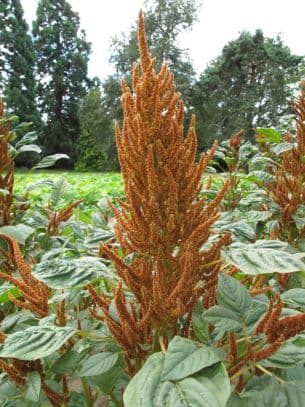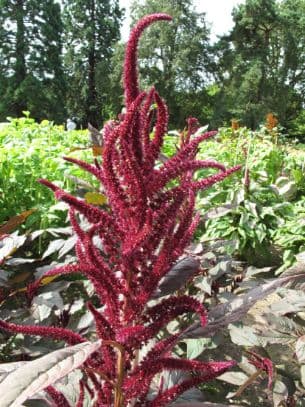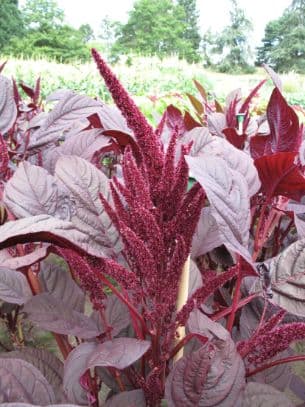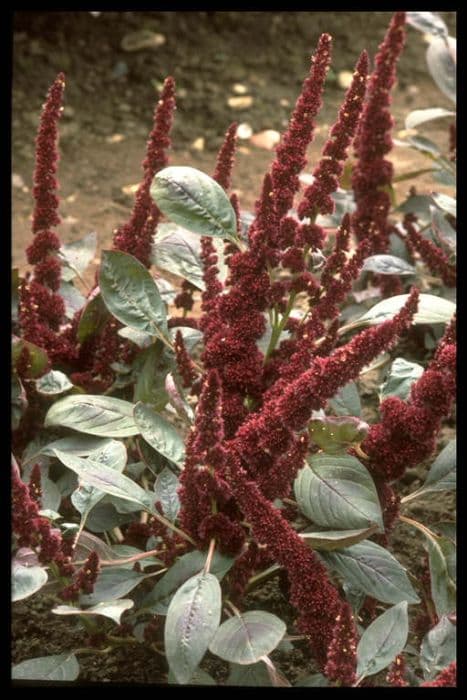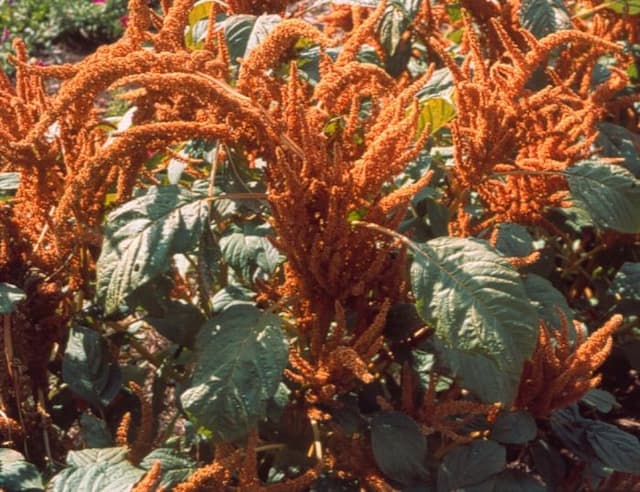Spinach Spinacia oleracea 'Renegade'

ABOUT
Spinacia oleracea 'Renegade' is commonly known as spinach. This particular variety is characterized by its vibrant green leaves that are tender and have a smooth texture. The leaves are typically triangular or arrow-shaped with a pointed tip and a slightly crinkled appearance, adding a visual appeal to the plant's overall look. The foliage grows in a rosette pattern, which can give it a compact and lush appearance. The stems of 'Renegade' spinach are slender and may have a green to slightly reddish hue, depending on the growing conditions. In terms of the life cycle, this plant is usually grown as an annual, meaning it completes its life cycle within one growing season. Its leaves have a rich green coloration, which indicates that the plant is packed with nutrients, making it not only an ornamental addition to a garden but also a nutritious one.
About this plant
 Names
NamesFamily
Amaranthaceae
Synonyms
Spinach
Common names
Spinacia oleracea.
 Toxicity
ToxicityTo humans
Spinach, specifically the variety 'Renegade', is not toxic to humans when consumed in reasonable amounts. It is actually a nutrient-rich vegetable that is widely consumed without adverse effects. However, it's important to note that consuming very large quantities of spinach can lead to an accumulation of oxalic acid, which can contribute to kidney stone formation in susceptible individuals. Additionally, individuals taking blood thinners should be cautious about consuming large amounts of spinach due to its high vitamin K content, which can affect blood clotting. In general, though, there is no toxicity concern for humans eating spinach.
To pets
Spinach, including the 'Renegade' variety, is not considered to be highly toxic to pets, such as dogs and cats, but it should still be fed in moderation. Spinach contains oxalates, which in excessive amounts could lead to kidney issues, particularly in pets with preexisting kidney conditions. There is also a risk of digestive upset if a pet consumes a large amount of spinach. Nonetheless, in small quantities, spinach can be a healthy treat for many pets, but as with any food that is not part of their regular diet, it should be introduced slowly and in moderation to observe for any adverse reactions.
 Characteristics
CharacteristicsLife cycle
Annuals
Foliage type
Deciduous
Color of leaves
Green
Height
1 foot (30 cm)
Spread
1 foot (30 cm)
Plant type
Herb
Hardiness zones
2-11
Native area
Southwest Asia
Benefits
 General Benefits
General Benefits- High Nutritional Value: Spinach is rich in vitamins and minerals, including iron, calcium, and vitamins A, C, and K.
- Easy to Grow: Renegade Spinach is a hardy plant that can be easily cultivated in a variety of climates and soils.
- Fast Growing: Spinach grows quickly, allowing for a speedy harvest, often within 4-6 weeks of planting.
- Versatility in Cooking: Spinach can be eaten raw in salads or cooked in various dishes, offering culinary flexibility.
- Enhances Landscape: With its lush green leaves, it can add beauty to gardens and serves as an attractive ground cover.
- Succession Planting: Due to its rapid growth cycle, spinach allows for multiple plantings in one season for a continuous harvest.
- Improved Soil Health: Spinach can help retain soil moisture and suppress weeds, aiding in the overall health of the garden.
 Medical Properties
Medical Properties- High in antioxidants: Spinach contains antioxidants such as lutein and zeaxanthin, which may help protect the eyes against age-related macular degeneration.
- Rich in vitamins: It is a good source of vitamins A, C, and K, which contribute to immune function, skin health, and blood clotting.
- Heart health: Spinach contains nitrates and potassium, which have been associated with maintaining healthy blood pressure levels.
- Bone health: The vitamin K in spinach plays a role in bone health by working with calcium to boost bone density.
- Inflammation reduction: Spinach has components like alpha-lipoic acid that may help to reduce inflammation associated with chronic diseases.
- Digestive health: The fiber content in spinach can aid in digestion and prevent constipation.
- Blood sugar regulation: Alpha-lipoic acid in spinach has also been studied for its potential to lower blood sugar levels and increase insulin sensitivity.
 Air-purifying Qualities
Air-purifying QualitiesThis plant is not specifically known for air purifying qualities.
 Other Uses
Other Uses- Spinacia oleracea 'Renegade', commonly known as spinach, can be used as a natural dye for fabrics, providing a range of green hues depending on the mordant used.
- As a feed for various livestock such as chickens and rabbits, spinach can be a nutritious supplement to their regular diets.
- It can serve as a plant-based ink for art projects when the juice is extracted and potentially mixed with natural binders.
- Spinach leaves are sometimes used in floral arrangements and decorative food displays due to their vibrant color and large, attractive leaves.
- They can also be used in homemade organic mulches for garden beds, contributing to the soil's nutrient content as they decompose.
- The plants can act as a cool-season cover crop in agriculture, improving soil structure and fertility once tilled back into the soil.
- Used in educational settings, spinach plants can illustrate the process of photosynthesis and other plant biology topics to students.
- It has been utilized in biodegradable materials research, such as creating eco-friendly packaging from leaf fibers.
- Spinach may play a role in companion planting, potentially deterring pest insects from more sensitive plants in gardens or on farms.
- For those practicing natural or organic gardening, crushed spinach can also be part of a homemade pest repellent spray for other plants.
Interesting Facts
 Feng Shui
Feng ShuiSpinach is not used in Feng Shui practice.
 Zodiac Sign Compitability
Zodiac Sign CompitabilitySpinach is not used in astrology practice.
 Plant Symbolism
Plant Symbolism- Strength: Spinach, the common name for Spinacia oleracea 'Renegade', is often associated with strength due to its high nutrient content, notably iron, which is thought to be beneficial for physical power.
- Health: Due to its nutritional value, spinach is commonly symbolized as a plant that promotes overall health and vitality.
- Purity: The vibrant green color of spinach leaves is sometimes connected to cleanliness and purity, symbolizing a fresh start or cleansing of the body.
- Resilience: Spinach is a hardy plant that can grow in cooler climates, symbolizing one's ability to thrive despite challenging conditions.
- Vitality: Spinach's nutrient-rich profile also makes it a symbol of youthfulness and lively energy.
 Water
WaterSpinach, the common name for Spinacia oleracea 'Renegade', should be watered deeply once or twice a week, depending on the weather, to sustain healthy growth and prevent the roots from sitting in waterlogged soil. Estimate the use of about 1 gallon per square yard per week during cooler periods, and increase to twice that amount when the weather is hot and dry. It is essential to allow the soil to dry slightly between waterings, but not to the point of causing wilting. Frequent, lighter waterings should be avoided because they may encourage shallow rooting which can make the plants more susceptible to stress and disease.
 Light
LightSpinach requires full sun to partial shade to thrive, with at least 6 hours of direct sunlight per day. The best spot for planting spinach is in a garden that receives morning sunlight and some afternoon shade, especially in warmer climates. This will ensure the plant gets enough light without being exposed to the harsh afternoon sun which can stress the plant and lead to bolting.
 Temperature
TemperatureSpinach grows best in cool weather and can tolerate a frost. The ideal growing temperatures for spinach range between 50°F and 70°F. It can survive a minimum temperature down to around 20°F, and the maximum temperature should not exceed 75°F for extended periods, or it may bolt and produce seeds. It is most productive when grown in spring and fall, and it can be grown in winter in milder climates.
 Pruning
PruningPruning, or more appropriately thinning, is important for spinach to ensure plants have enough space for growth. Thin spinach seedlings to about 6 inches apart once they reach a height of 3 inches. This allows for adequate airflow around the plants, which helps prevent fungal diseases. The best time for pruning is in the early stages of growth when plants are young. Additional pruning isn't required unless leaves become damaged or diseased, in which case they should be removed promptly.
 Cleaning
CleaningNot needed
 Soil
SoilSpinach 'Renegade' requires well-draining soil with rich organic matter; a mix of garden soil, compost, and perlite is ideal. The soil pH should be between 6.0 and 7.0 for optimal growth.
 Repotting
RepottingSpinach 'Renegade' is typically grown as an annual and does not require repotting. Plant fresh seeds or seedlings each season for continuous harvest.
 Humidity & Misting
Humidity & MistingSpinach 'Renegade' tolerates standard outdoor humidity levels but does not require specific humidity adjustments when grown indoors.
 Suitable locations
Suitable locationsIndoor
For indoor Spinach 'Renegade', use pots with drainage and place in bright light.
Outdoor
Grow Spinach 'Renegade' in full sun to partial shade, fertile soil.
Hardiness zone
Spinach 'Renegade' is suitable for USDA zones 2-11.
 Life cycle
Life cycleSpinacia oleracea 'Renegade', commonly known as spinach, begins its life as a seed, which, when sown in nutrient-rich soil and exposed to suitable temperature and moisture conditions, germinates. The seedling stage follows, where two small 'seed leaves' or cotyledons emerge, then true leaves develop as it enters the vegetative growth stage. During the vegetative growth, the plant produces a rosette of leaves that grows close to the ground. As the plant matures, it enters the bolting stage where it stretches out and forms a flowering stalk if exposed to long daylight hours or significant temperature changes. The bolting is followed by the flowering and pollination stage, where spinach produces small, inconspicuous flowers that are wind-pollinated, leading to the production of seeds. Finally, once the seeds are mature, the plant completes its life cycle, senesces, and eventually dies, having disseminated seeds for the next generation.
 Propogation
PropogationPropogation time
Spring
Spinacia oleracea 'Renegade', commonly known as spinach, is typically propagated through seeds. The ideal time for sowing spinach seeds is either in the spring or fall when the soil temperatures are cool, generally ranging from 40 to 75 degrees Fahrenheit (4 to 24 degrees Celsius). For spring crops, seeds should be sown as soon as the soil is workable. For a fall crop, seeds are usually planted 6 to 8 weeks before the first expected frost. The seeds should be planted about half an inch (1.3 centimeters) deep, in rows 12 to 18 inches (30 to 46 centimeters) apart. Regular watering is necessary to ensure germination, which usually takes 7 to 14 days. Once seedlings emerge, thinning is recommended to allow about 3 inches (7.6 centimeters) between plants, which gives room for the plants to grow and minimizes competition for nutrients and light.

